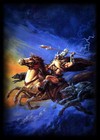Lyrics
Odin is considered the chief god in Norse mythology and Norse paganism. His role, like many of the Norse pantheon, is complex. He is a god of wisdom, war, battle and death. He is also attested as being a god of magic, poetry, prophecy, victory and the hunt.
Odin is an ambivalent deity. Old Norse (Viking Age) connotations of Odin lie with "poetry, inspiration" as well as with "fury, madness and the wanderer." Odin sacrificed his left eye at Mímir's spring in order to gain the Wisdom of Ages. Odin gives to worthy poets the mead of inspiration, made by the dwarfs. Odin is associated with the concept of the Wild Hunt, a noisy, bellowing movement across the sky, leading a host of slain warriors.
Consistent with this, Snorri Sturluson's Prose Edda depicts Odin as welcoming the great, dead warriors who have died in battle into his hall, Valhalla, which, when literally interpreted, signifies the hall of the slain. The fallen, the einherjar, are assembled and entertained by Odin in order that they in return might fight for, and support, the gods in the final battle of the end of Earth, Ragnarök.
He is also a god of war, appearing throughout Norse myth as the bringer of victory. In the Norse sagas, Odin sometimes acts as the instigator of wars, and is said to have been able to start wars by simply throwing down his javelin Gungnir, and/or sending his valkyries, to influence the battle toward the end that he desires. The Valkyries are Odin's beautiful battle maidens that went out to the fields of war to select and collect the worthy men who died in battle to come and sit at Odin's table in Valhalla, feasting and battling until they had to fight in the final battle, Ragnarök. Odin would also appear on the battle-field, sitting upon his eight-legged horse Sleipnir, with his two ravens, one on each shoulder, Hugin (Thought) and Munin (Memory), and two wolves(Geri and Freki) on each side of him.
Odin is also associated with trickery, cunning, and deception. Most sagas have tales of Odin using his cunning to overcome adversaries and achieve his goals, such as swindling the blood of Kvasir from the dwarves.
Odin and his brothers, Vili and Ve, are attributed with slaying Ymir, the Ancient Giant, to form Midgard. From Ymir's flesh, the brothers made the earth, and from his shattered bones and teeth they made the rocks and stones. From Ymir's blood, they made the rivers and lakes. Ymir's skull was made into the sky, secured at four points by four dwarfs named East, West, North, and South. From Ymir's brains, the three Gods shaped the clouds, whereas Ymir's eye-brows became a barrier between Jotunheim (giant's home) and Midgard, the place where men now dwell. Odin and his brothers are also attributed with making humans.
After having made earth from Ymir's flesh, the three brothers came across two logs (or an ash and an elm tree). Odin gave them breath and life; Vili gave them brains and feelings; and Ve gave them hearing and sight. The first man was Ask and the first woman was Embla and from them all human families are descended. Many kings and royal houses claim to trace their lineage back to Odin through Ask and Embla.
Odin ventured to Mímir's Well, near Jötunheim, the land of the giants; not as Odin, but as Vegtam the Wanderer, clothed in a dark blue cloak and carrying a traveller's staff. To drink from the Well of Wisdom, Odin had to sacrifice his left eye, symbolizing his willingness to gain the knowledge of the past, present and future. As he drank, he saw all the sorrows and troubles that would fall upon men and the gods. He also saw why the sorrow and troubles had to come to men.
Mímir accepted Odin's eye and it sits today at the bottom of the Well of Wisdom as a sign that the father of the gods had paid the price for wisdom. Sacrifice for the greater good is a recurring theme in Norse mythology, as in the case of Tyr, who sacrificed his hand to fetter Fenrisulfr.
Odin was said to have learned the mysteries of se

